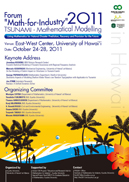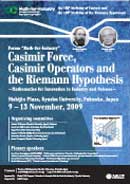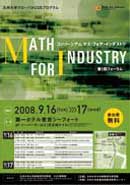Satellite Lectures at Kyushu University
Satellite Lectures at Kyushu University
Yuji KODAMA (Department of Mathematics, Ohio State University, USA)
"Representation of the real Grassmannian and its application to an integrable system"
October 9, Tuesday 13:00-
October 10, Wednesday TBA
October 11, Thursday TBA
October 12, Friday TBA
Abstract(Japanese): 実グラスマン多様体、Gr(k,n), は実 n 次元ベクトル空間の k 次元部分空間の集合として 定義される。集中講義では、Gr(k,n) のシューベルト胞体分割とそれを更に細分したデオダー分割等を 概説し、その応用として KP 方程式と呼ばれる2次元非線形分散波動方程式のソリトン解の分類を 解説する。特に分割には、ヤング図形の升目に白石と黒石をある規則に従って配置した「碁図形」を 定義し、ソリトン波形がこの図形より構成出来ることを説明する。また、分類から得られたソリトン解の 浅水重力波への応用も説明する予定です。
Soo Teck Lee (National University of Singapore)
"Branching rules and branching algebras for the complex classical groups"
October 10, Wednesday 10:00-12:00
October 17, Wednesday 10:00-12:00
November 8, Thursday 10:00-12:00
November 14, Wednesday 10:00-12:00
November 22, Thursday 10:00-12:00
"GL_n tensor product algebra and the Littlewood-Richardson rule"
October 31, Wednesday 13:00-14:30(Representation Theory Seminar)
Jonathan Hosking (IBM T. J. Watson Research Center, US)
"L-moments: mathematical theory and statistical applications"
October 16, Tuesday 16:40-18:40
October 18, Thursday 16:40-18:40
October 19, Friday 16:40-18:40
L-moments are expectations of certain linear combinations of order statistics. They form the basis of a general theory which covers the summarization and description of theoretical probability distributions, the summarization and description of observed data samples, estimation of parameters and quantiles of probability distributions, and hypothesis tests for probability distributions. L-moments are in analogous to the conventional moments, but are more robust to outliers in the data and enable more secure inferences to be made from small samples about an underlying probability distribution. They can be used for estimation of parametric distributions, and can sometimes yield more efficient parameter estimates than the maximum-likelihood estimates. These lectures will present a general summary of L-moment theory and methods, and describe some applications ranging from environmental data analysis to financial risk management. Time permitting, we will also cover some recent developments on nonparametric quantile estimation, "trimmed" L-moments for very heavy-tailed distributions, and L-moments for multivariate distributions.
※ We recommend that you take the preparatory lecture given by Dr. Shingo Saito on October 11, Thursday 16:40-18:40 at Chu-Seminar Room 1
Konrad Polthier (Freie Universitat Berlin)
Overview
The series of talks will give an overview of the areas of mathematical visualization and discrete and applied geometry. At an introductory level the talks introduce to visualization techniques and underlying concepts from geometry. Several applications from scientific visualization, computer aided design, architecture and computer graphics are presented. The courses will include lots of visual material, animated movies and interactive software experiments.
"Visualization in Mathematics"
October 18, Thursday 14:50-18:10
This introductory talk experiences mathematics from a visual point of view. Using fascinating images we dive into various disciplines and present mathematical insight that may have previously seemed inaccessible to novices. This talk will be complemented with animated movies from the MathFilm festival.
"Curvature of Discrete Shapes"
November 1, Thursday 14:50-18:100
This talk is more theoretical and introduces simplicial meshes as basic concepts in mathematical visualization, computer graphics and finite element numeric. Here we use meshes as a concept of discretization and provide several important properties from a beginners' point of view including various notions of curvature. Software experiments will connect and provide several applications of the learned techniques.
"Surface Optimization and Optimal Shapes"
November 8, Thursday 14:50-18:10
The geometry processing pipeline describes stages from 3D scanning via several key algorithms to 3D printing. Special focus lies on various optimization techniques such as noise removal, feature enhancement, segmentation and compression. As a guiding principle we will introduce physical and mathematical properties of soap bubbles and soap films, and get in touch with minimal surfaces and other optimal surfaces.
"Deformable Shapes and Animation"
November 16, Friday 14:50-18:10
Animation of shapes uses several techniques to get physically most realistic motion while still keeping the size of meshes at a reasonable size. Here we introduce various natural energies to control surface deformations and provide intuitive and effective tools for fast interactive surface modeling and animation. An outlook on spectral techniques including surface signatures and mesh filtering is given.









